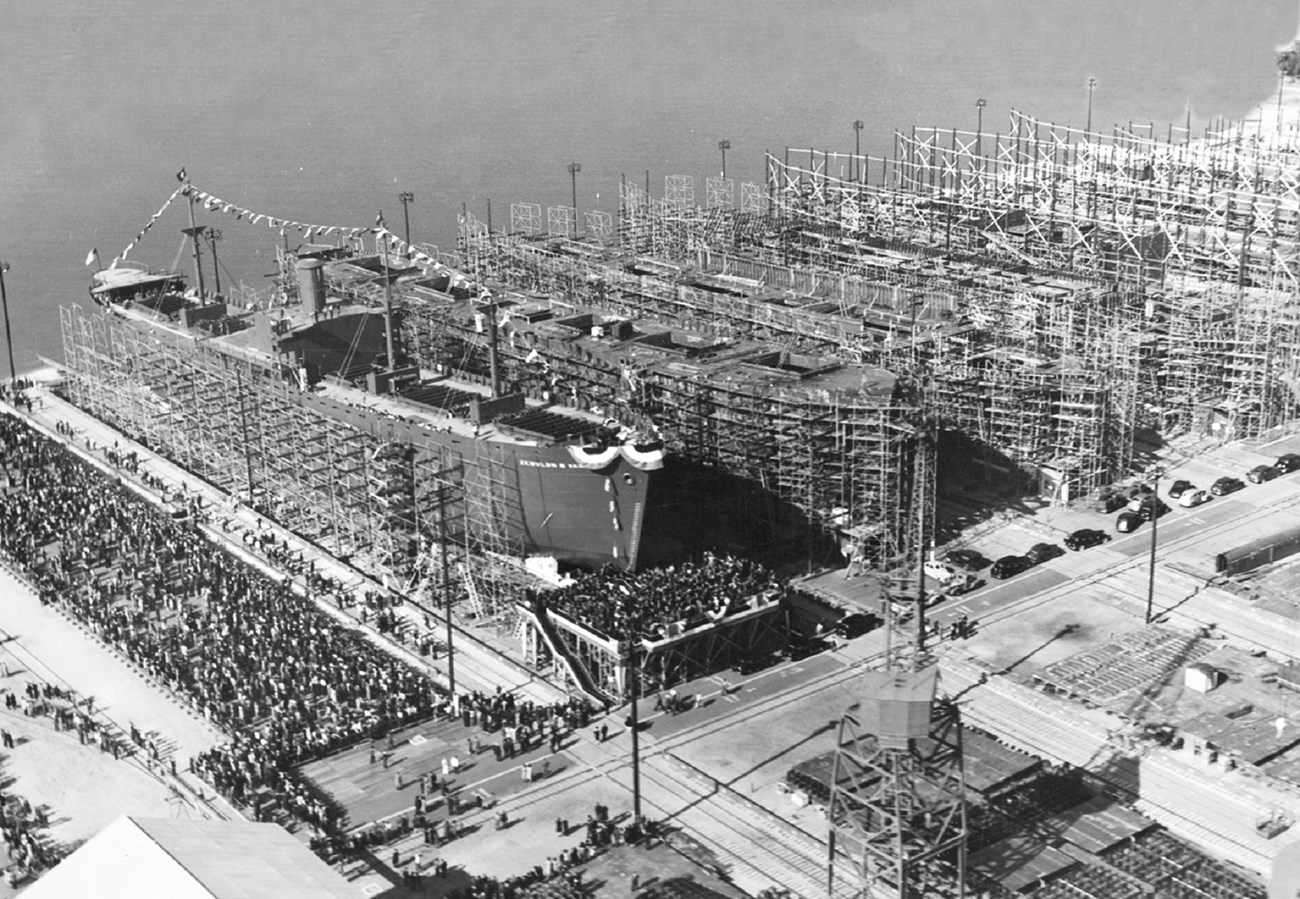Last updated: December 7, 2023
Article
Wilmington, North Carolina

East Carolina Digital Collections
American World War II Heritage City
In the first half of the twentieth century commerce expanded in Wilmington, North Carolina. However, starting in 1929 the Great Depression shattered the region's economy and forced many people out of work. The Wilmington Relief Association, formed by local citizens after the stock market crash, helped by subsidizing the cost of public works projects. But it was the opening of the North Carolina Shipbuilding Company during the Second World War that ultimately revived the area’s economy, transforming Wilmington into “The Defense Capital of the State”.
By January of 1941, Great Britain was in desperate need of supplies, but the U.S. lacked the large numbers of merchant vessels needed to transport cargo overseas. At the request of President Roosevelt, the U.S. Maritime Commission ordered the construction of two hundred new ships. Because the U.S. lacked the infrastructure to support such a large order, the Maritime Commission developed the Emergency Shipbuilding Program, an effort to construct new shipyards along the Atlantic, Gulf, and Pacific coasts. In the South the shipyards were also intended to help stimulate the region’s economy and to take advantage of a large labor force, an abundance of natural resources, and a warmer climate.
After receiving approval from the Maritime Commission, the Newport News Shipbuilding and Dry Dock Company began construction of a new shipyard along the east bank of the Cape Fear River on February 3, 1941. The company also established a subsidiary, the North Carolina Shipbuilding Company, to operate the shipyard. The shipyard transformed Wilmington into an industrial hub and spurred people to move to the Wilmington area, resulting in the city’s population increasing from 33,000 to 50,000. By 1943, the shipyard employed approximately 20,000 people. Of those, 1,628 were women and 6,000 were African Americans.
The North Carolina Shipbuilding Company was the largest wartime industrial effort in North Carolina. It employed thousands of workers, reaching its peak of 21,000 employees in 1943. The company's first female workers served as tool checkers, but eventually many were able to be promoted to more skilled jobs, such as welding, and operating woodworking machines and drill presses. African American employees worked in many skilled positions, among them riveters, riggers, drillers, and shipwrights. A shipyard hiring this number of African Americans was uncommon in the South. While integrated crews existed in the shipyard, the company mandated segregation of employee facilities such as the cafeteria and locker areas. Shipyard employees, who received national recognition for their efficiency and advanced techniques, built 234 ships between 1941 and 1946. The North Carolina Shipbuilding Company was one of ten shipyards in the country that specialized in building Liberty Ships. This class of cargo vessels was mass produced during the war and was designed to transported ammunition, tanks, vehicles, and other military supplies.
While thousands of people found jobs in Wilmington at the shipyard and other industrial sites, the large numbers of new residents put pressure on the city’s infrastructure and produced a housing and food shortage. The federal government intervened and constructed 1,700 housing units. A lot next to to the shipyard was converted into a trailer camp for employees. Families and individual employees who couldn't find housing were forced to construct makeshift shelters using tents and old railroad cars.
The USO club in downtown Wilmington at Second and Orange Streets became a popular off-duty site for hundreds of thousands of service members stationed at bases in neighboring cities, such as Camp Davis, Camp Lejeune, and Cherry Point. When it opened in 1941, volunteers at the club organized radio broadcasts, dances, theatre productions, childcare, and art exhibits for approximately 35,000 service members per week. The basement was converted into a dormitory that could accommodate up to 600 men. Because Jim Crow laws in the South restricted these facilities to white servicemen and women, a separate club for African American service members was built. This club was on Nixon Street, fifteen blocks north of the USO club. The USO club at Second and Orange Streets still stands and is now the Hannah Block Historic USO/Community Arts Center. Unfortunately, the club for African American service members was demolished after the war. It was sold to the Boys Club in 1947, and a new building was constructed on the site around 1978.
After the war, local preservation efforts encouraged by the passage of the National Historic Preservation Act of 1966 led to the listing of most of downtown Wilmington in the National Register of Historic Places. The USS North Carolina, which currently sits in the Cape Fear River, was designated as a National Historic Landmark in 1986.
In September 2020, Wilmington, North Carolina was designated as an American World War II Heritage City.
The American World War II Heritage City program recognizes the historic importance of the United States’ involvement in World War II, the wartime contributions of its citizens, and current efforts to preserve and memorialize the home front in jurisdictions across the country. Created by the John Dingell Jr. Conservation, Management and Recreation Act of 2019, and coordinated by the National Park Service, the program tells jurisdictions' home front stories that reflect one of the most transformative eras of our nation’s history.
